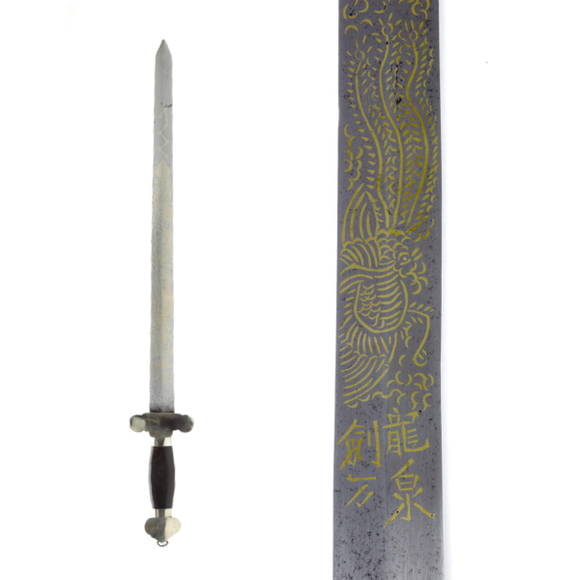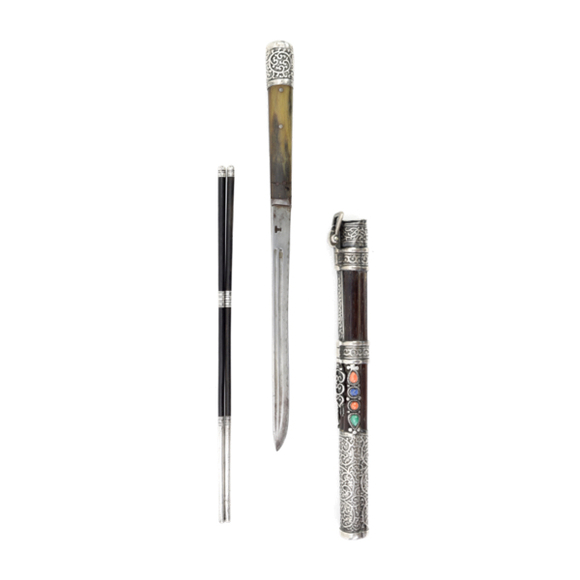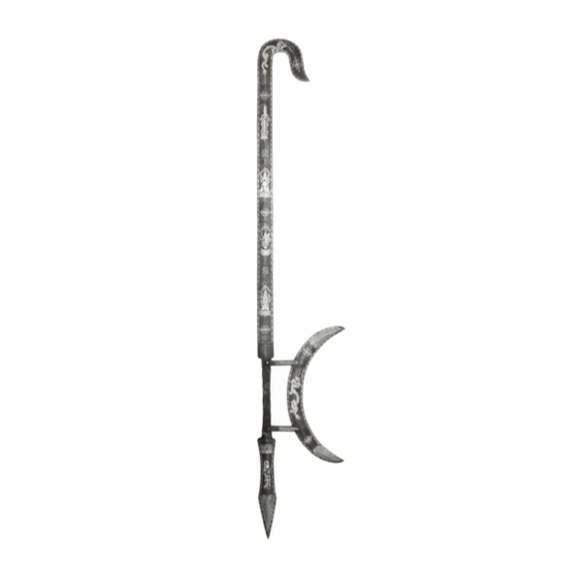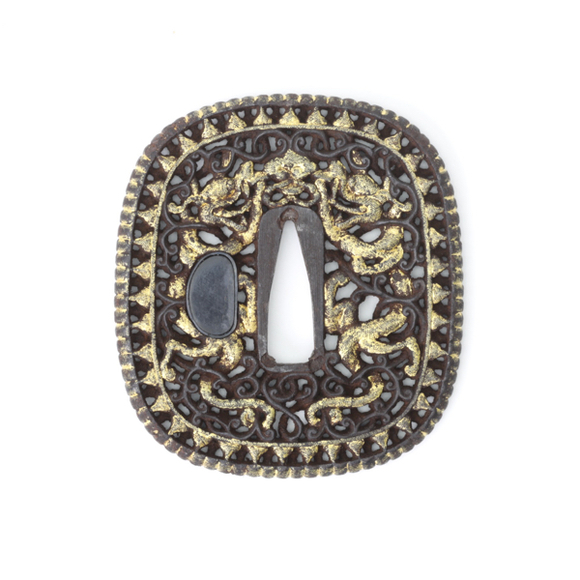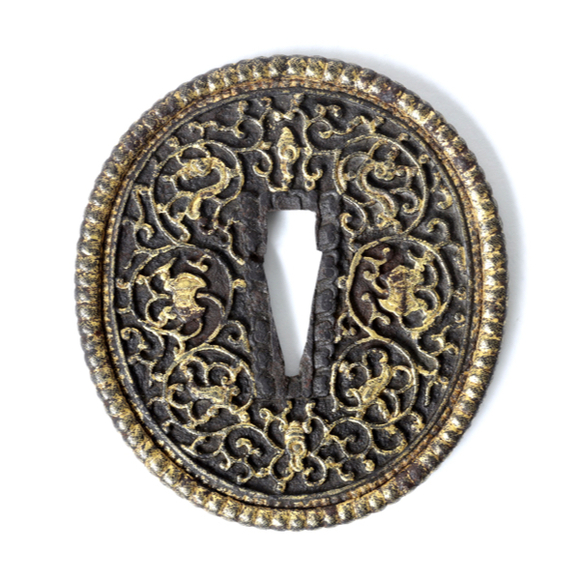A Chinese shortsword made by a well-known Longquan maker.

I.) 154 cm
II.) 155.5 cm
I.) 77.5 cm
II.) 77 cm
I.)
Base 11.8 mm
At hook 7 mm
5 cm from tip 4 mm
II.)
Base 11 mm
At hook 8 mm
5 cm from tip 4.5 mm
I.)
Base 48 mm
At hook 83 mm
II.)
Base 43 mm
At hook 72 mm
I.) 2830 grams
II.) 2400 grams
I.) 1 cm from guard
II.) 5 mm under guard
Southern China
Probably Guangzhou garrisson
Mid to late 19th century
I.) UK antique art market
II.) From an American collection
Introduction
A pair of Chinese semi-pole arms. With their almost 1:1 hilt-to-blade ratio they are perhaps best described as hǔyádāo (虎牙刀), "tiger tooth swords".
Bearers of such arms often formed a second line behind rattan shield troops of the téngpáiyíng (藤牌營). Such use goes back all the way to the 17th century, where Dutch commander Frederik Coyett describes the deployment of Coxinga's rattan shield troops:
"... his soldiers used three types of weapons, some were armed with bow and a quiver hanging from behind their backs, others had a shield on their left arm and a good saber in their fist. The third kind had a large battle sword on a staff half the length of a man, held with both hands.
The shieldmen were used in place of cavalry, who were guided by their commanders, one every ten men, with their shields covered, with lowered heads, tried to penetrate the enemy lines, and bring disorder, which they did with such fury and carelessness, as if each of them had left a spare body in a crate at home, penetrating enemy lines enduringly, notwithstanding how many of them were overrun, on which none took any note, as to proceed as wild dogs, without ever looking back to see whether they were followed [by their companions] or not.
Those with battle swords on staffs, called “soap knives” by the Dutch, are in the place of our pikemen, to prevent breaching [of the lines], and to preserve order among the troops, but when the enemy was brought in disorder, they would massacre the fleeing men."1
-Frederik Coyett, 1675
(My own translation from the old Dutch)
Description
A set of two hǔyádāo (挑刀) of the late Qing dynasty. Their blade profile, thickness at base, guard design and shaft construction all point toward a Southern Chinese manufacture.
The impressive blades are thick and mostly straight before sweeping up dramatically. The backs of the tips are cusped, and there is a substantial hook on the back of each. Such hooks are more commonly seen on yǎnyuèdāo (偃月刀), pole arms with a much shorter blade in relation to the pole.
The base of both blades are signed with military marks:

I.)
滿正白旗
Mǎn zhèng bái qí
"Man(chu) Plain White Banner"
Manchu Bannermen were a hereditary warrior class that formed the elite force of the Qing. The Plain White Banner was of the Upper Three banners that was under the direct control of the emperor.
II.)
漢正紅旗
Hàn zhèng hóng qí
"Han Plain Red Banner"
Hàn here is short for Hànjūn or "Chinese martial", a hereditary army of ethnic Han bannermen who were descendants of Han soldiers who joined the Qing cause early on.
They enjoyed privileges similar to the Manchu and Mongol Bannermen, and after the fall of the Qing, all families under the Hànjūn were considered to be Manchu because they were part of the Eight Banners system.
Additional marks
The blades are further marked with a single, partially stamped mark at the base.

勝
Shēng
"Superior"
A feature often seen on Southern military weapons and something that I have come to think of as proof marks of some sort.
Condition
Both blades have quite some edge damage, and one also has a cut in the spine, indicating they have seen action. This is not unusual on Chinese arms, as the 19th century was the stage of many bloody conflicts including the Opium Wars and the Taiping Rebellion.
There is also corrosion and pitting on blades, plus some damage and losses to shafts. The Han example is missing two of the ferrules that once went around the shaft. Patina on the wood indicates one was lost much longer than the other. The Manchu example has a crack in the guard. See photos.
Hafts
Both shafts are of a reddish hardwood, with brass ferrules and pommel cap. They are not cut lengthwise as is usually the case, but are hollowed out from one side to accommodate the tang. The opening was then covered by a strip of wood.
The Manchu-marked one has the ferrules secured with screws and a screwed nut at the base. The Han marked one misses the two center ferrules and has a more traditional construction with rivets and a peened pommel. The Manchu one may have been the first to use these new techniques available or may just postdate the other.

Conclusion
The Banner markings make this a very interesting set, it shows how Han and Manchu Bannermen of Southern China of the late 19th century used pretty much the same weapons.
The majority of Southern Chinese weapons that have any markings at all have Han Bannerman markings, I've seen less than a handful of Manchu markings in my over 20 years in this field.
I did not acquire them as a set and so am also willing to sell them separately.











Typical Chinese hook sword, with seldom-seen fine silver wire overlay.
With the swirling arabesque motifs that are typical for this period.

